Ijraset Journal For Research in Applied Science and Engineering Technology
- Home / Ijraset
- On This Page
- Abstract
- Introduction
- Conclusion
- References
- Copyright
Study on Work Permit System
Authors: Shik Tameez, Kandasamy R, Selvaraj G
DOI Link: https://doi.org/10.22214/ijraset.2022.45815
Certificate: View Certificate
Abstract
The work permit system offers one of the best methods to meet various conditions required for making a hazardous operation safe and easy to perform and Safety precautions to be taken during the work. To Eliminate Fire And Explosion Hazards To Protect The Human Lives, Property And Environment by Following With Work Permit System.
Introduction
I. INTRODUCTION
Permit to Work system is a formal safety control document designed to prevent injury to employees, contractors and third parties as well as to property, particularly when Work with foreseeable high hazard content is undertaken. The Permit sets out the Work to be done, precautions to be taken and the responsibilities of individuals. This guidance is intended to assist Line Managers, Head teachers, and people in Charge of divisional units to ensure that a safe system of work is in place for Maintenance work, small or short term projects where previously hazardous Conditions have been identified. A permit to work system will be required to ensure no Worker is subjected to any significant risk, and also in fulfilling legal obligations under the Health and Safety at Work Act 1974, and The Management of Health and Safety Regulations 1999.
A permit to work system forms an essential part of a safe system of work. It also forms an integral part of a risk assessment process, where specific hazards are identified, and suitable control measures are implemented prior to commencement of the work task. However, it is important to ensure that people carrying out work task where a permit to work system is required have the necessary competence to undertake the job safely.
Hot work permits (HWPs) are required for any process that may produce an ignition source in a work area in which flammable vapors or gases may be present. Governmental regulations require this [OSHA(c); (d); (g); (a); (h); (f); (i)] and voluntary industry standards recommend it [NFPA(a); (b); API(b); (a)]. To issue an HWP, a hazard assessment must be performed. To do so, combustible gas and vapor concentrations must be determined for the work area and job classification in question, then compared to acceptable standards. As noted, combustible gas and vapor concentrations are generally determined using an LEL meter; these devices may be portable or fixed-location monitors.
II. METHODOLOGY
Occupational health and safety issues across various industries in India are alarming, so the need to mitigate the risk associated with jobs is highly important for better control of health and safety of employed workers. This study has been conducted in a reputed industry with a deep understanding on the associated hazards in different type of tasks, their various control measures to minimize the risk and propose suitable suggestions on areas of improvement to achieve a “Zero Incident” target as per the company SHE objectives
This study can be used as a reference for further comprehensive research in the similar verticals of businesses, which will greatly help the user to achieve his/her objectives and helps in accomplishing the work successfully.
A. Safe System of Work
It is a controlled and considered way of carrying out a work task, which eliminates the risk to health and safety so far as it is reasonably practicable. It sets out the work to be done and precautions to be taken. Hence, in its simplest form. Safe System of Work = Risk Assessment + Method Statement.
B. Confined Space
An enclosed or partially enclosed space that is not intended or designed primarily for human occupancy, within which there is a risk of one or more of the following:
- An oxygen concentration outside the safe oxygen range;
- A concentration of airborne contaminant that may cause impairment, loss of consciousness or asphyxiation;
- A concentration of flammable airborne contaminant that may cause injury from fire or explosion; or
- Engulfment in a stored free-flowing solid or a rising level of liquid that may cause suffocation or drowning.
C. Fall
means a fall by a person from one level to another that is reasonably likely to cause injury to the person or any other person.
D. Hot Work
Grinding, welding, thermal or oxygen cutting or heating, and other related heat-producing or spark-producing operations.
E. Risk of fall
Means circumstances in which the worker or person is:
- In or on an elevated workplace from which a person could fall;
- In the vicinity of an opening through which a person could fall;
- In the vicinity of an edge over which a person could fall;
- On a surface through which a person could fall; or
- In any other place from which a person could fall.
F. Method Statement
This is a document detailing how a particular task will be carried out. It should detail all the possible dangers/risk associated with the job, and the methods of controls to be established to show how the job would be managed safely.
III. TYPES OF PERMITS
These permits shall be for specific jobs/ work under specific situations that require additional precautions. The auxiliary permits shall be required in addition to the Master Permit when such jobs are intended to be carried out. These shall be pre-numbered starting with 0001 after the prefix. The following work situations shall qualify for use of auxiliary permits.
A. Hot Work Permit
Hot work shall be defined as any activity capable of producing flames, sparks, heat generation, or any other forms of ignition. Examples include.
- Arc welding, soldering, bitumen melting, use of any equipment with open flames (e.g. blowtorches, space heaters),
- Grinding, buffing, cutting, drilling, chiseling, hot plate/ hot air welding,
- Vehicles, tools and equipment powered by internal combustion and not certified for use in areas where Hot Work Permit is required etc.
- Non certified electrical equipment including battery operated vehicles.
- Personal electrical equipment such as radio, portable telephones, cameras, cell phones etc. unless certified as intrinsically safe.
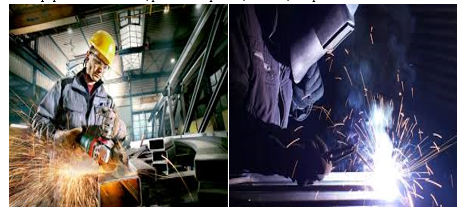
a. Precautions/ Considerations
Following shall be considered while authorizing for carrying out hot work:
- The first and foremost attempt shall be that wherever practical, hot work or the use of tools, equipment or vehicles that could introduce an ignition source shall be avoided in areas where flammable vapors or combustible materials are present (Zone-1 and Zone-2). Where flammable vapors could be present, appropriate atmospheric testing shall be recorded before and during permit validity. Work shall not be allowed to continue when the testing indicates 10% LEL or more.
- Necessary and adequate arrangements shall be made to remove, where practical, all possibly combustible materials, isolating and purging process equipment with inert gas (e.g. nitrogen) where necessary, and using fire blankets and screens to contain hot debris, before commencing hot work.
- A fire watchman shall be required during, upon completion, and after completion of hot work. The fire watchman shall remain
at the site of hot work for as long as it is continuing. A check for smoldering debris shall be made during and after completion
of the work (e.g. an hour later
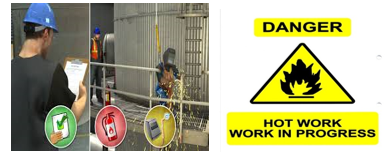
- Precautions to be made shall include suitable first aid firefighting devices like fire extinguishers, sand (dry) buckets etc. at the site of hot work, or if not possible within ten meters of the job, as well as a review of the local fire alarm and response procedures.
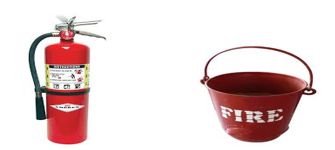
b. Recommendation and Authorization of Hot Work Permit
Recommendation for Authorization of Permit shall be made by the Maintenance Supervisor/ Manager after risk assessment based on the method statement outlined by the initiator on the Hot Work permit. Risk assessment shall be carried out jointly with the initiator for areas outside manufacturing plants. For manufacturing areas, the risk assessment team shall include any one of the Production/ Area officer/Executive. Maintenance Supervisor/ Manager shall assure themselves that the work can be carried out safely. In case of work in Zone I area the Risk assessment shall be documented on the Permit. Prior to the recommendation for authorization, precautions/ considerations as mentioned above shall be adhered to. Where required, EHS Manager shall assist in providing guidance in terms of any special precautions that may be required.
Hot Work in Manufacturing Areas, areas of stores where flammable materials are stored, shall be authorized by Production Head. Hot work in engineering and EHS areas shall be authorized by Engineering Head. In the absence of the Production Head and Engineering Head, the hot work shall be authorized by Location Head. In case none of the above authorized persons are available, no hot work shall be authorized. Prior to authorization of the permit, Shift Safety person / EHS Manager shall verify and certify that all requirements of the permit have been met & all precautions taken.
Any exception to the above shall be made only by the Location Head based on written risk assessment.

B. Confined Space Entry Permit
- Entry to confined space shall be defined as going into the space or insertion of the head into the opening in a confined space.
Following shall be considered, but not limited to, as confined spaces:
- Storage Tanks
- Silos
- Reaction Vessels
- Mixing vessels (all types),
- Closed filters like Agitated Nutsche Filter (ANF),
- Driers (all types),
- Excavations of more than 1.5 meters including soil surcharge.
- Enclosed drains
- Sewers
- Open-topped chambers like inside the pit of Road Weigh Bridge.
- Combustion chambers in furnaces
- Ductwork
- Areas above the False ceiling
- Unventilated or poorly ventilated rooms
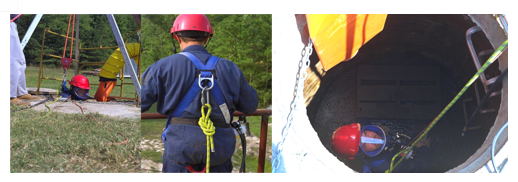
In addition, some places may become confined spaces when work is carried out, or during their construction, fabrication or subsequent modification.
Where work needs to be done in a confined space, appropriate Confined Space Entry Permit shall be used prior to entry. Where required, EHS Manager/Shift Safety person shall assist in providing guidance in terms of any special precautions that may be required.
The permit for entry to confined spaces shall be authorized by Production Head. Engineering head is authorized to sign in engineering and EHS areas. In the absence of the Production Head, Engineering Head the permit shall be authorized by Location Head. In case none of the above authorized persons are available, no confined space entry shall be permitted. Prior to authorization of the permit, Shift safety Person / EHS Manager shall verify and certify that all requirements of the permit have been met & all precautions taken.
2. Precautions/ Considerations
Entry to confined spaces shall be avoided as far as reasonably practicable through checking if the work can be done another way by modifying the confined space itself so that entry is not necessary; or by having the work done from outside.
However, in case the entry cannot be avoided, following precautions shall be taken beyond the Master permit requirements while authorizing for Confined Space Entry Permit:
a. No one shall be allowed to enter a confined space until a valid permit is authorized and training is provided to the person entering a confined space.
b. The persons identified for issuing and authorizing the permit as well as the one entering into a confined space shall be limited to those who are competent, have demonstrated experience and/or training in confined space entry techniques.
c. Attendant(s) trained in emergency response and rescue, and confined space entry procedures shall be accounted for in the permit. Their role shall be to remain at the confined space at all times while it is occupied.
d. Occupational Health Centre (OHC) shall be informed in advance about the confined space entry.

e. Means of emergency rescue and communication shall be identified (lifelines, winches, radios, etc.) and provided before the permit is authorized. The rescue plan shall be reviewed by the issuer and acceptor and signed for.
f. Identification and positive tested LOTO of all hazardous chemicals or stored energy shall be provided for.
3. Consideration of dangers during Risk Assessment, prior to Authorization of Permit
- Lack of oxygen
- Presence of hazardous material, poisonous gas, fumes or vapors including residues left in tanks, vessels etc., or remaining on internal surfaces.
- Liquids and solids that can suddenly fill the space, or release gases into it, when disturbed.
- Fires and explosions (from flammable vapors, excess oxygen etc.)
- Hot conditions leading to a dangerous increase in body temperature.
- Other dangers arising due to the nature of work being carried out, like possibility of dust arising on use of portable grinders; electric shock from dust extraction blowers; gas, fumes or vapors arising from welding or from adhesives (if being applied) etc.
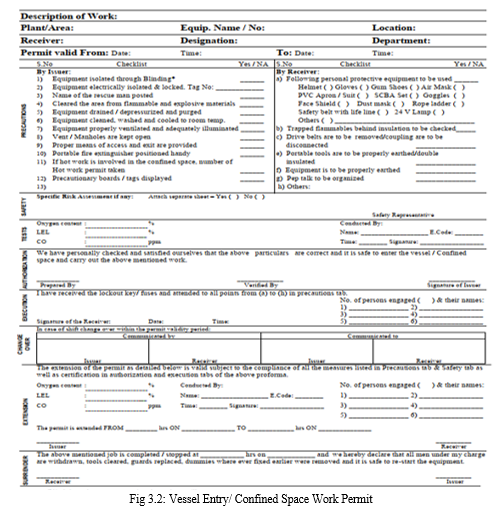
C. Excavation / Break In
Any work involving breaking of the ground surface, driving in of spikes, piling by either hand or mechanical means will be defined as an excavation/ digging. Similar work applicable to building shall be considered as a Break-In.
Where excavation needs to be done beyond 0.3 meter (1 feet), an Excavation Permit shall be required. The permit to enter confined space shall also be required when the depth of excavation plus soil surcharge exceeds 1.5 meters.
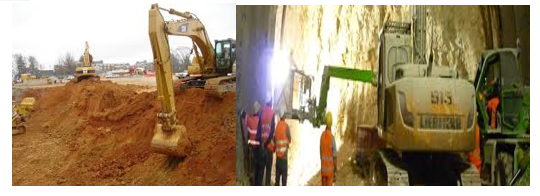
- Precautions/ Considerations
Prior to issuing the permit the following shall be checked for and provisions shall be made to protect people from the associated hazards:
a. Underground services like cables (power, telephone, computer) and pipelines (hydrant, sewerage, aqueous effluent pipelines leading to ETP) etc. & Concealed electrical/utility lines in case of break-in.

b. Possibility of collapse of sides: It shall be ensured that necessary equipment needed such as trench sheets, props, baulks etc. are available on site, and site cordoned/ barricaded before work starts. Unsupported excavations beyond 1.2 metre shall not be permitted.
c. Materials, People and vehicles falling into the excavation:
People and vehicles shall be prevented from falling into excavations by ensuring that the work area is cordoned/ barricaded and there is minimal road traffic in the area. Proper warning shall be displayed for vehicle movement. Where vehicles are required to tip materials into excavations, stop blocks shall be provided to prevent them from over-running. If excavation is 2 meter or deeper, substantial barriers like guard rails and toe boards shall be provided.
d. Undermining nearby structures: It shall be ensured that excavations do not affect the footings of scaffolds or the foundations of nearby structures. In-case required, civil supervisor shall survey/ inspect the work place and provide temporary support before digging starts.
e. Access to the excavation: Good ladder access or other safe ways of getting in and out of the excavation shall be provided.
f. Fumes: Since exhaust fumes can be dangerous, petrol or diesel engine equipment shall not be sited in or near the edge of the excavation unless fumes can be ducted away or the area is well ventilated.
2. Inspection and Supervision
a. A competent person shall supervise the installation, alteration or removal of the excavation support.
b. People working in excavations shall be given clear instructions on how to work safely.c.
- A competent person shall inspect the excavations:
- Before the work begins, at the start and end of each shift, and when work ends.
- After any event likely to have affected the strength or stability of the excavation; and
- After any accidental fall of rock, earth or other material.
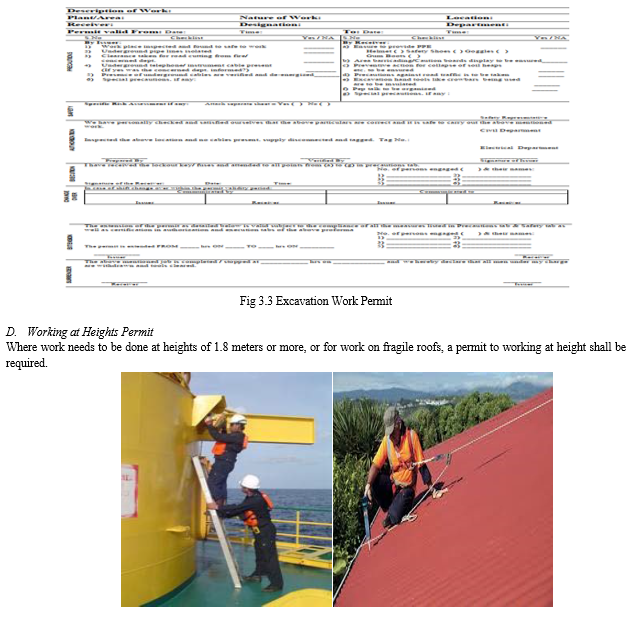
Engineering Head shall authorize the permit. In his absence Manager Maintenance shall authorize the permit. Where required, EHS Manager/Shift Safety Person shall assist in providing guidance in terms of any special precautions that may be required.
Appropriate risk assessment shall be carried out and approved. All recommendations shall be satisfied before commencement of work.
Working at heights shall be preferably carried out during periods of daylight only. Working beyond daylight hours shall need written approval of Location Head.
- Precautions/ Considerations
a. Where frequent access to a particular point is required, suitable permanent platform shall be provided. If not available, it shall be installed. Where and when infrequent access is required, a temporary platform shall be used.
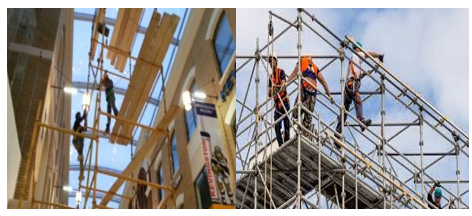
b. While working at height on a platform or roof, following factors shall be considered:
- Competence of working people;
- Ground condition (stability, slope, slippery etc.);
- Weather conditions like heat, cold, rain or lightening;
- Overhead pipes, cables, power lines etc.;
- Protection of people or equipment below;
- Where possible, re-routing of pedestrian or vehicle;
- Removal of wastes, if any;
- Safe access and escape in case of an emergency;
- The suitability, capability and loading restrictions of the platform or roof to people and materials;
- Guard rails, fall arrestors and anchorage points.
- Routine inspections and maintenance;
- Prompt removal of any temporary access equipment after use;
c. Whenever possible, access to top of road and rail tankers and other high-speed vehicles shall be avoided. If access is required like for sampling purpose, then access shall be through a permanent platform and adequate protection shall be taken to prevent falls.
d. Where contractors are required to carry out work on roofs or erect temporary platforms, the Manager maintenance shall assess their competence.
Scaffolding: No bamboo/ wooden scaffolding shall be used. All scaffolding shall be of steel pipes conforming to IS: 1161:1964 or SA106 Gr. B of ASTM Sch 40 and shall be free from defects and corrosion. These shall be used with proper couplers. Securing scaffolding pipes with rope shall be prohibited.
During installation of the scaffolding, a board indicating “UNDER CONSTRUCTION – NOT TO BE USED” in RED shall be displayed and area barricaded.
Once certified as complete by the competent person, a board indicating “READY FOR USE” in GREEN shall be displayed and area shall be released for work.
Forklift Trucks/ Battery Operated stackers shall not be used for temporary access to heights.
Inspection of Temporary Access equipment shall be carried out by the Maintenance Charge man/ Supervisor to evaluate continued suitability.
Fragile surfaces/ Roofs: Maintenance Charge man/ Supervisor shall ensure that no one working under his control goes onto or near a fragile surface/ roof/ skylights unless that is the only reasonably practicable way for the worker to carry out the work safely, having regard to the requirements of the task, equipment, or working environment.
If anyone is required to work on or near fragile surfaces/ roofs/ skylights following shall be ensured:
- As far as reasonable practicable to do so, suitable platforms, coverings, guard rails, and the likes are provided and used to minimize the risk.
- Do all that is reasonably practicable, if any risk of a fall remains, to minimize the distance and effect of a fall?
- Make the worker aware of the danger and prominently display warning notices fixed at the approaches to the danger zone.
Falling Objects: Maintenance/ Civil Supervisor shall ensure that all that is reasonably practicable shall be done to prevent anything falling. Where this is not reasonably practicable, he shall ensure that:
- Nothing is thrown from height or
- Stored in such a way that its movement is likely to injure anyone.
- The area is cordoned off/ barricaded, and clearly indicated so that unauthorized people do not reach it.
- Only enclosed rubbish chutes are used to throw items at a construction site.
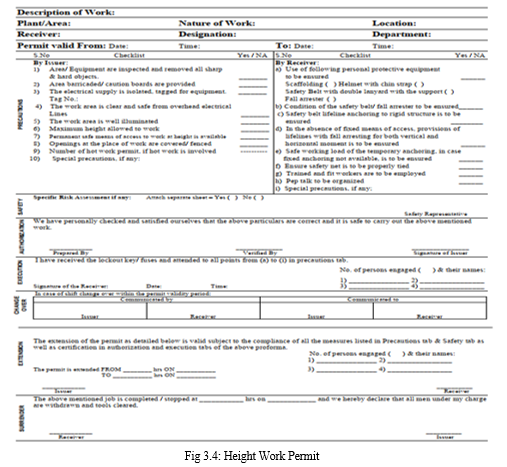
E. Electrical Work Permit
Working with electricity can be dangerous. Engineers, electricians, and other professionals work with electricity directly, including working on overhead lines, cable harnesses, and circuit assemblies. Others, such as office workers and sales people, work with electricity indirectly and may also be exposed to electrical hazards. Workers in the electric power industry are potentially exposed to a variety of serious hazards, such as arc flashes (which include arc flash burn and blast hazards), electric shock, falls, and thermal burn hazards that can cause injury and death. For all “Electrical isolation and energisation of equipment / line-HT” or “Electrical isolation and energisation of equipment / line-LT” permit shall be taken, depending on the case. Similarly “Permit to work on HT line and Equipment” or “Permit to work on LT line and Equipment” shall be taken by user Department depending on the case. Clearance certificate shall also be taken as the case may be. Electrical equipment should be properly isolated and grounded. However in a manned Grid Substation, this activity will be carried out by the concerned grid operation staff & the Permit Holder in this case has to confirm the same before starting the job.
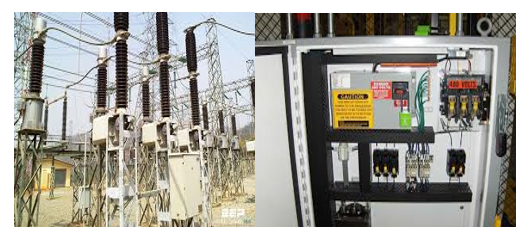
Permits for work shall be applied by an authorized person to take line clear and shall be issued by the Engineer (or competent person in charge of operation) in writing in the form prescribed. No line or equipment should be made again live until the permit issued on it, is returned. A ‘separate PTW format’ shall be used for the jobs of long duration especially, more than 3 days that fall under the category of electrical work. Additionally, the Permit Holder has to ensure that necessary precautions should be taken so that the concerned equipment is not energized by any normal switching operation. The same person who takes the permit should return the permit.
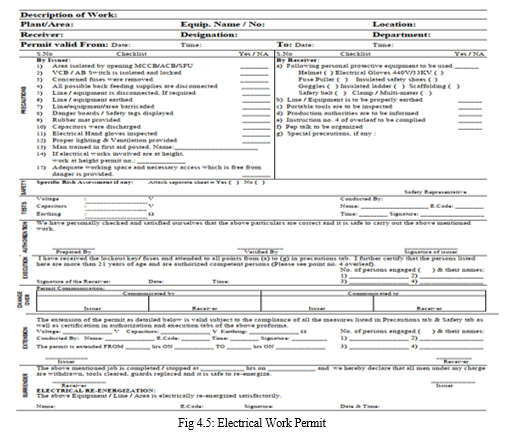
F. Validity
For all permits the issuer shall mention the requested validity period and Authorizing Person shall approve the mentioned period. Master and Excavation / Break-In Permits can be renewed on daily basis up to six days after which a fresh permit shall be required. All other permits shall be for date of authorization (08:30 hrs – 17:00 hrs).
IV. ROLE OF ISSUERS AND ACCEPTORS OF THE WORK PERMITS
Following shall be the roles:
|
1 |
Issuers |
|
|
2 |
Acceptors |
|
.NOTE: First copy of the work permits to be handed over to the person doing the job, after job completion same to be submitted to Eng. dept. and second copy to be retained by the issuer for record, for a period of 1 month (from the date of last issued permit in the book)
A. Closure of Permit / De-isolation
Permit to work shall be closed when either of the below situation arises:
- Work is complete
- There is a change of intent
- Issuer stops the job
- Period of Validity expires
Before the termination it shall be ensured that the work is completed and the plant/ equipment is ready for re-commissioning. After work is completed, all locks and tags shall be removed, all tools recovered, and guards and other safety devices reinstalled. With personnel in safe positions, restart, and where necessary, the equipment shall be test operated. Affected employees shall be notified of completed LOTO status.
The permit shall be closed only after the Issuer and Acceptor have reviewed the situation and are satisfied to this effect. Closure shall be recorded on the first copy of the Permit by the signature of both the Issuer and the Acceptor.
Any limitations on the use of the plant (with respect to safety and housekeeping) after Hand back shall be recorded in the permit.
NOTE: (a) Closure of permit shall be upon handing back & taking back after completion of job and recording the same by signing the first copy of the permit issued to the engineering department. (b) All completed Work Permit books shall be retained for a period of one month (from the date of last issued permit in the book) by the respective department.
B. Training
No matter how well designed the work permit system is, it will only succeed if the staff are aware that it exists and understand how to comply with it.
- Provide training, preferably as a group, to all possible users and staff involved in the permit system. Explain how the work permit system can help prevent accidents, injuries and death
- Outline the duties and responsibilities of each party. Emphasize that the teamwork is critical. The person filling out the form, the person preparing the work area, and the person doing the job must each carry out their responsibilities thoroughly for the system to work. Since the work permit is designed to protect the employees against hazards that can cause critical injuries or death, all participants should be trained to identify hazards.
- Provide supervisors with special training necessary for them to determine that working conditions are safe at all times.

The workers to be informed to report any hazards and they should know the early warning signs and symptoms of the presence of a hazard. For example, an odour similar to rotten eggs may indicate exposure to hydrogen Sulphide.
Workers must also be instructed to stop work and evacuate the area immediately.
a. Ordered by an authorized person
b. A fire or evacuation alarm sounds
c. They believe they are in danger.
C. Control on Work Permit
It is important to monitor and maintain the work permit system to ensure that it is being followed correctly and that it is effective. Include work permit procedures as part of the workplace inspections. Review the work permit system at least every six months. Also consult the staff on the effectiveness of the system and consider their suggestions to improve it
Other control measures may include
- in-plant spot checks that work permits are being used, and complied with properly
- questions or tests to establish a person's competence to qualify as authorized signer
- review of written procedures and the permit form used
- a detailed investigation of all incidents under work permit conditions
- everyday validity of work permit system should be checked
- It is essential to close the work permit after work.
D. Benefits of Work Permit System
Work Permit provides written information on the prevalent hazards connected with the job performance. It spells out suitable precautions to be taken & remedial measures to be adopted to encounter the hazardous conditions that can be encountered while performing the job. It indicates the various types of personal protective equipment to be used at different stages of work
- It serves as predetermined checklist for various safety precautions to betaken
- It provides a written record of the operation including the personal who were involved in authorizing and carrying out the operations
- The permit system which necessitates carrying out of various tests and safe guards instill a sense of security from accidents in the minds of crew performing the job
- The work permit system proved to be one of the most satisfactory methods of ensuring positive control over hazardous operation performed in unfavorable conditions
Conclusion
The work permit system offers one of the best methods to meet various conditions required for making a hazardous operation safe and easy to perform and Safety precautions to be taken during the work.
References
[1] Acer, K.S. and S.R. Bayer. “OSHA Revamps Rules for Monitoring Confined Spaces.” Pollution Engineering. Oct. 1990: 41-44. [2] American Chemistry Council (ACC). Responsible Care 14001: Technical Specification. Arlington, VA: ACC, 2001. [3] National Fire Protection Assn. (NFPA)(a). ANSI/NFPA 51B, Standard for Fire Prevention in Use of Cutting and Welding Processes. Quincy, MA: NFPA, 1994. [4] NFPA(b). ANSI/NFPA 306, Standard for the Control of Gas Hazards on Vessels. Quincy, MA: NFPA, 1997. [5] American Petroleum Institute (API)(a). API 750, Management of Process Hazards. Washington, DC: API, Jan. 1990. [6] API(b). API 2009, Safe Welding, Cutting and Other Hot Work Practices in Refineries, Gas Plants and Petrochemical Plants. 6th ed. Washington, DC: API, Sept. 1995 [7] Blank, M. “Prevent Hot Work Fires Through Management.” Occupational Hazards. July 1999: 40-42. [8] British Standards Institute (BSI). Occupational Health and Safety Management Systems 18002: Guidelines for the Implementation of OHSAS 18001. London: BSI, 2000. [9] Chelton, C.F., ed. Manual of Recommended Practice for Combustible Gas Indicators and Portable Direct-Reading Hydrocarbon Detectors. 2nd ed. Fairfax, VA: AIHA, 1993. DiNardi, S.R. The Occupational Environment: Its Evaluation and Control. Fairfax, VA: AIHA, 1999.
Copyright
Copyright © 2022 Shik Tameez, Kandasamy R, Selvaraj G. This is an open access article distributed under the Creative Commons Attribution License, which permits unrestricted use, distribution, and reproduction in any medium, provided the original work is properly cited.

Download Paper
Paper Id : IJRASET45815
Publish Date : 2022-07-20
ISSN : 2321-9653
Publisher Name : IJRASET
DOI Link : Click Here
 Submit Paper Online
Submit Paper Online

